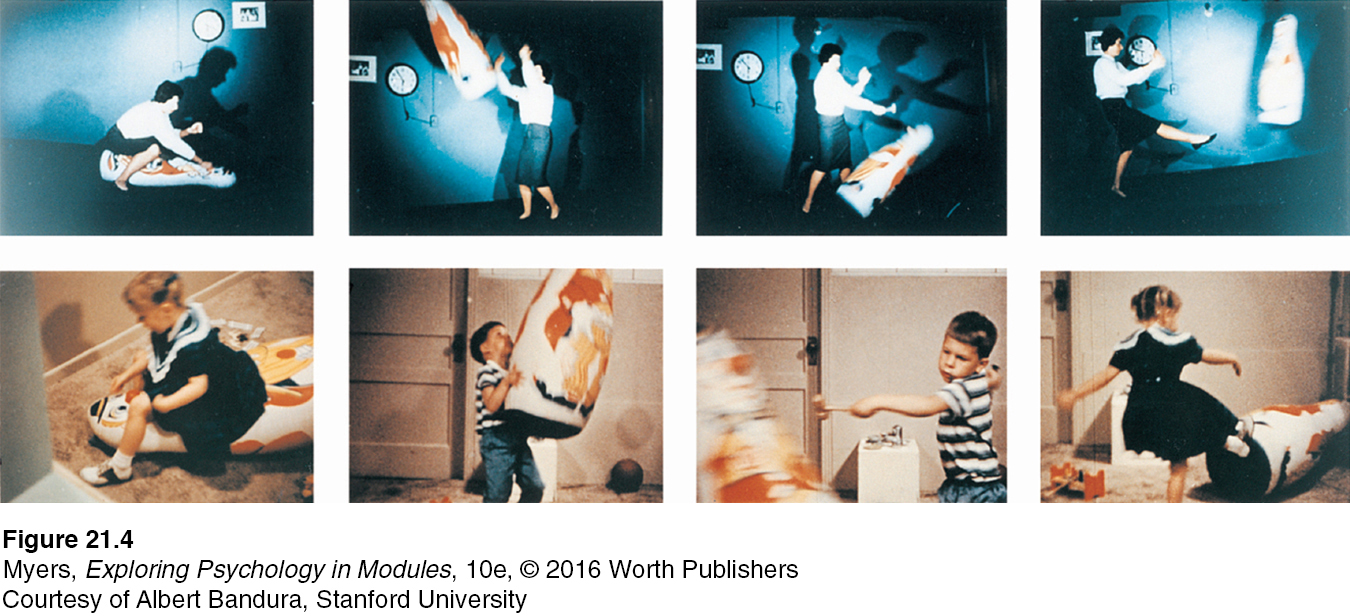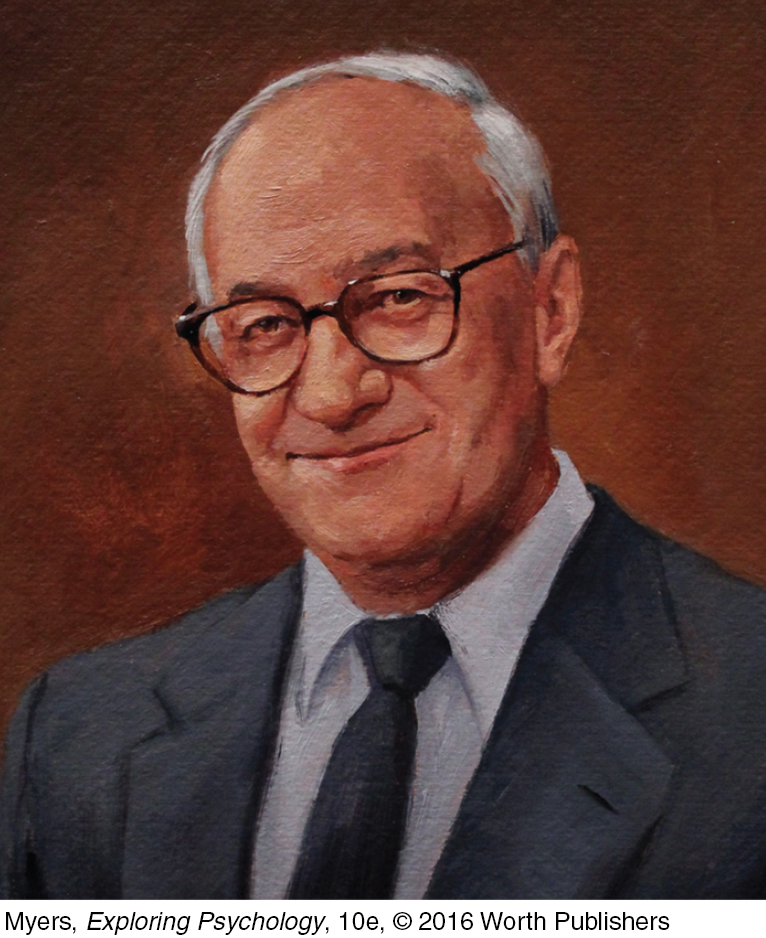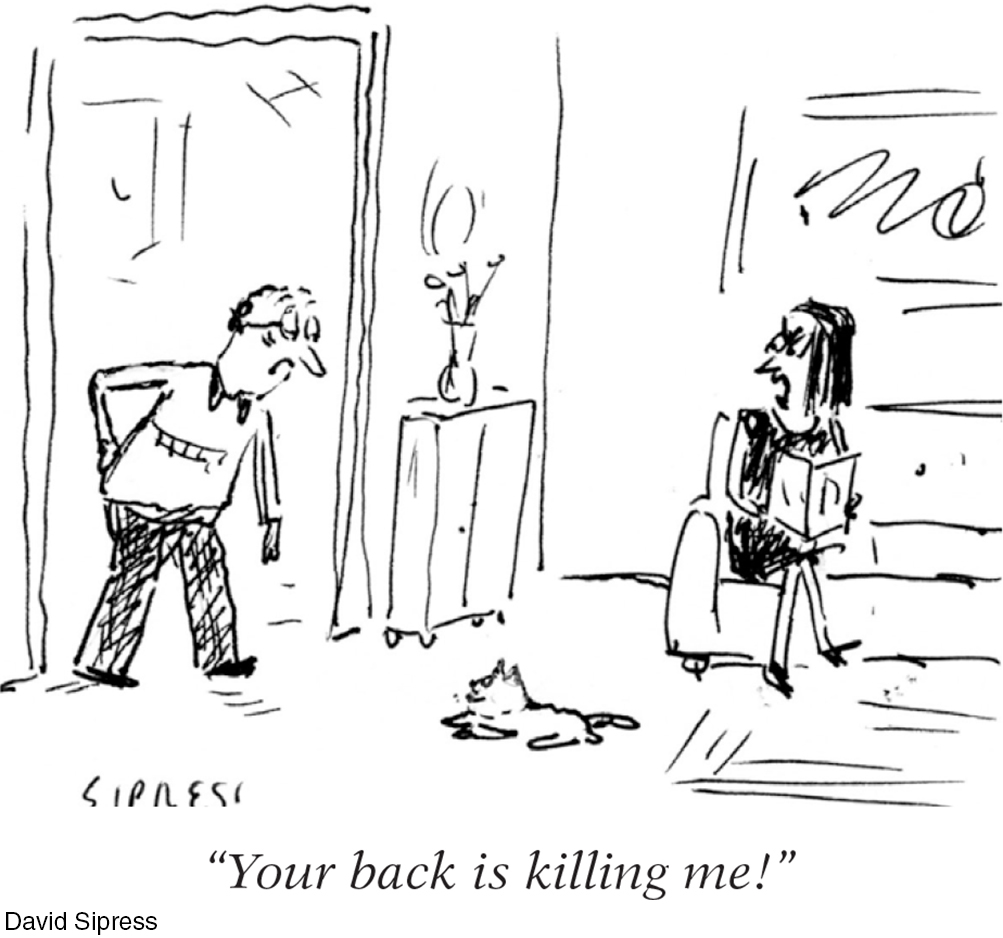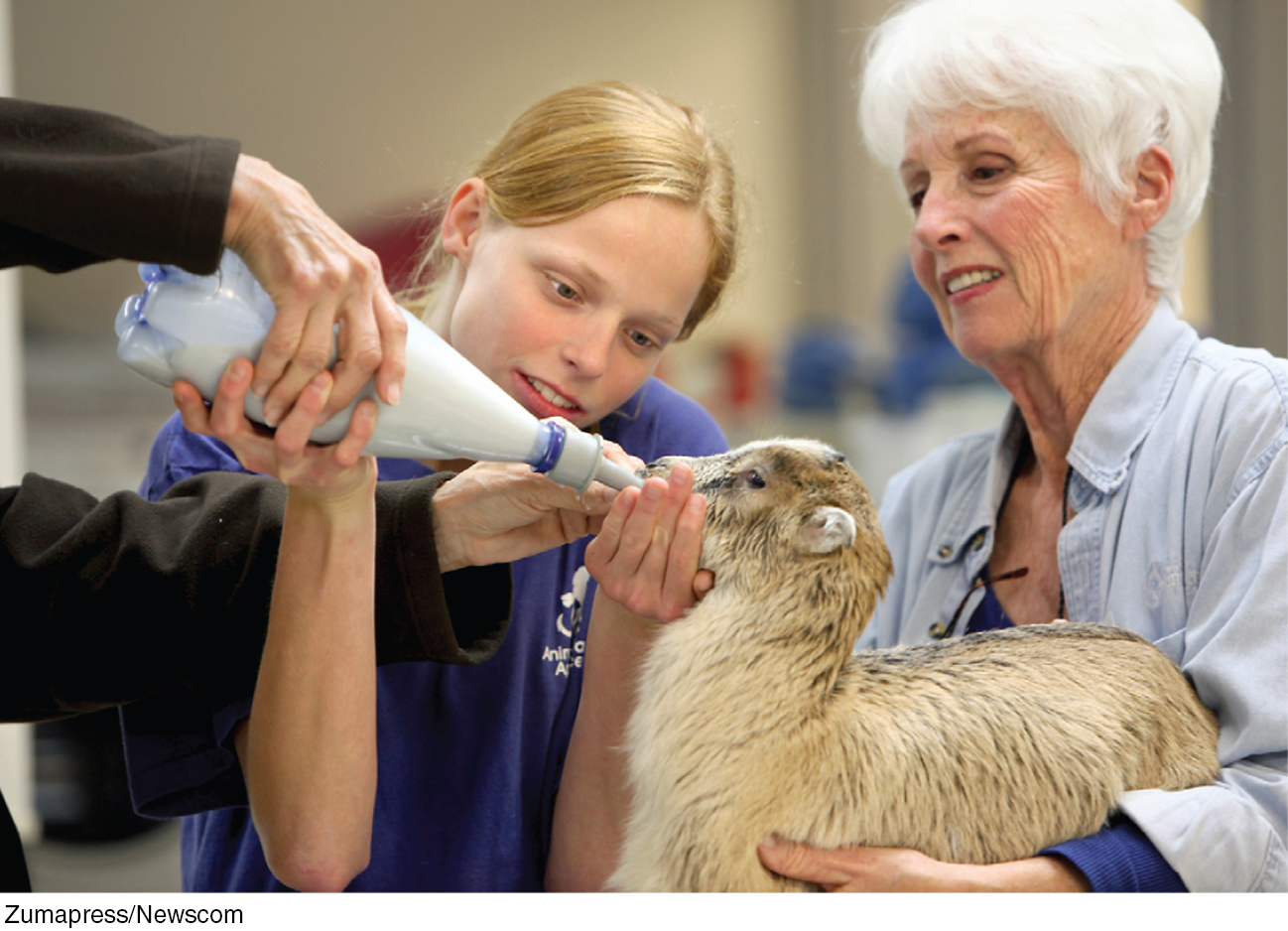21.3 Learning by Observation
21-
observational learning learning by observing others.
modeling the process of observing and imitating a specific behavior.
 For three minutes of classic footage, see LaunchPad’s Video: Bandura’s Bobo Doll Experiment.
For three minutes of classic footage, see LaunchPad’s Video: Bandura’s Bobo Doll Experiment.
Cognition supports observational learning, in which higher animals, especially humans, learn without direct experience, by watching and imitating others. A child who sees his sister burn her fingers on a hot stove learns not to touch it. We learn our native languages and various other specific behaviors by observing and imitating others, a process called modeling.
Picture this scene from an experiment by Albert Bandura, the pioneering researcher of observational learning (Bandura et al., 1961): A preschool child is working on a drawing, while an adult in another part of the room builds with Tinkertoys. As the child watches, the adult gets up and for nearly 10 minutes pounds, kicks, and throws around the room a large inflated Bobo doll, yelling, “Sock him in the nose… . Hit him down… . Kick him.”
The child is then taken to another room filled with appealing toys. Soon the experimenter returns and tells the child she has decided to save these good toys “for the other children.” She takes the now-
Compared with children not exposed to the adult model, those who viewed the model’s actions were more likely to lash out at the doll. Observing the aggressive outburst apparently lowered their inhibitions. But something more was also at work, for the children imitated the very acts they had observed and used the very words they had heard (FIGURE 21.4).

That “something more,” Bandura suggested, was this: By watching models, we experience vicarious reinforcement or vicarious punishment, and we learn to anticipate a behavior’s consequences in situations like those we are observing. We are especially likely to learn from people we perceive as similar to ourselves, or as successful, or as admirable. fMRI scans show that when people observe someone winning a reward (and especially when it’s someone likable and similar to themselves), their own brain reward systems activate, much as if they themselves had won the reward (Mobbs et al., 2009). When we identify with someone, we experience their outcomes vicariously. Even our learned fears may extinguish as we observe another safely navigating the feared situation (Golkar et al., 2013). Lord Chesterfield (1694–
Mirrors and Imitation in the Brain

On a 1991 hot summer day in Parma, Italy, a lab monkey awaited its researchers’ return from lunch. The researchers had implanted wires next to its motor cortex, in a frontal lobe brain region that enabled the monkey to plan and enact movements. The monitoring device would alert the researchers to activity in that region of the monkey’s brain. When the monkey moved a peanut into its mouth, for example, the device would buzz. That day, as one of the researchers reentered the lab, ice cream cone in hand, the monkey stared at him. As the researcher raised the cone to lick it, the monkey’s monitor buzzed—

mirror neurons frontal lobe neurons that some scientists believe fire when performing certain actions or when observing another doing so. The brain’s mirroring of another’s action may enable imitation and empathy.
The same buzzing had been heard earlier, when the monkey watched humans or other monkeys move peanuts to their mouths. The flabbergasted researchers had, they believed, stumbled onto a previously unknown type of neuron (Rizzolatti et al., 2002, 2006). These presumed mirror neurons, they argued, provide a neural basis for everyday imitation and observational learning. When a monkey grasps, holds, or tears something, these neurons fire. And they likewise fire when the monkey observes another doing so. When one monkey sees, its neurons mirror what another monkey does. (For a debate regarding the importance of mirror neurons, which are sometimes overblown in the popular press, see Gallese et al., 2011; Hickok, 2014.)
Imitation is widespread in other species. Chimpanzees observe and imitate all sorts of novel foraging and tool use behaviors, which are then transmitted from generation to generation within their local culture (Hopper et al., 2008; Whiten et al., 2007). So, too, with monkeys. Researchers trained groups of vervet monkeys to prefer either blue or pink corn by soaking one color in a disgusting-

In humans, imitation is pervasive. Our catchphrases, fashions, ceremonies, foods, traditions, morals, and fads all spread by one person copying another. Children and even infants are natural imitators (Marshall & Meltzoff, 2014). Shortly after birth, babies may imitate adults who stick out their tongue. By 8 to 16 months, infants imitate various novel gestures (Jones, 2007). By 12 months (FIGURE 21.5), they look where an adult is looking (Meltzoff et al., 2009). And by 14 months, children imitate acts modeled on TV (Meltzoff, 1988; Meltzoff & Moore, 1989, 1997). Even as 2½-year-

So strong is the human predisposition to learn from watching adults that 2-
Humans, like monkeys, have brains that support empathy and imitation. Researchers cannot insert experimental electrodes in human brains, but they can use fMRI scans to see brain activity associated with performing and with observing actions. So, is the human capacity to simulate another’s action and to share in another’s experience due to specialized mirror neurons? Or is it due to distributed brain networks? That issue is currently being debated (Gallese et al., 2011; Iacoboni, 2008, 2009; Mukamel et al., 2010; Spaulding, 2013). Regardless, children’s brains do enable their empathy and their ability to infer another’s mental state, an ability known as theory of mind.
“Children need models more than they need critics.”
Joseph Joubert, Pensées, 1842
The brain’s response to observing others makes emotions contagious. Through its neurological echo, our brain simulates and vicariously experiences what we observe. So real are these mental instant replays that we may misremember an action we have observed as an action we have performed (Lindner et al., 2010). But through these reenactments, we grasp others’ states of mind. Observing others’ postures, faces, voices, and writing styles, we unconsciously synchronize our own to theirs—
Seeing a loved one’s pain, our faces mirror the other’s emotion. But as FIGURE 21.6 shows, so do our brains. In this fMRI scan, the pain imagined by an empathic romantic partner triggered some of the same brain activity experienced by the loved one who actually had the pain (Singer et al., 2004). Even fiction reading may trigger such activity, as we mentally simulate (and vicariously experience) the feelings and actions described (Mar & Oatley, 2008; Speer et al., 2009). In one experiment, university students read (and vicariously experienced) a fictional fellow student’s description of overcoming obstacles to vote. A week later, those who read the first-

Applications of Observational Learning
21-
So the big news from Bandura’s studies and the mirror-
prosocial behavior positive, constructive, helpful behavior. The opposite of antisocial behavior.
PROSOCIAL EFFECTS The good news is that prosocial (positive, helpful) models can have prosocial effects. Many business organizations effectively use behavior modeling to help new employees learn communication, sales, and customer service skills (Taylor et al., 2005). Trainees gain these skills faster when they are able to observe the skills being modeled effectively by experienced workers (or actors simulating them).
People who exemplify nonviolent, helpful behavior can also prompt similar behavior in others. India’s Mahatma Gandhi and America’s Martin Luther King, Jr., both drew on the power of modeling, making nonviolent action a powerful force for social change in both countries. The media offer models. For example, one research team found that across seven countries, viewing prosocial TV, movies, and video games boosted later helping behavior (Prot et al., 2014).

Parents are also powerful models. European Christians who risked their lives to rescue Jews from the Nazis usually had a close relationship with at least one parent who modeled a strong moral or humanitarian concern; this was also true for U.S. civil rights activists in the 1960s (London, 1970; Oliner & Oliner, 1988). The observational learning of morality begins early. Socially responsive toddlers who readily imitated their parents tended to become preschoolers with a strong internalized conscience (Forman et al., 2004).
Models are most effective when their actions and words are consistent. Sometimes, however, models say one thing and do another. To encourage children to read, read to them and surround them with books and people who read. To increase the odds that your children will practice your religion, worship and attend religious activities with them. Many parents seem to operate according to the principle “Do as I say, not as I do.” Experiments suggest that children learn to do both (Rice & Grusec, 1975; Rushton, 1975). Exposed to a hypocrite, they tend to imitate the hypocrisy—

ANTISOCIAL EFFECTS The bad news is that observational learning may also have antisocial effects. This helps us understand why abusive parents might have aggressive children, and why many men who beat their wives had wife-
“The problem with television is that the people must sit and keep their eyes glued to a screen: The average American family hasn’t time for it. Therefore the showmen are convinced that … television will never be a serious competitor of [radio] broadcasting.”
New York Times, 1939
TV shows, movies, and online videos are sources of observational learning. While watching, children may learn that bullying is an effective way to control others, that free and easy sex brings pleasure without later misery or disease, or that men should be tough and women gentle. And they have ample time to learn such lessons. During their first 18 years, most children in developed countries spend more time watching TV than they spend in school. The average teen averages, across 365 days a year, more than 4 hours a day; the average adult, 3 hours (Robinson & Martin, 2009; Strasburger et al., 2010).
Screen time’s greatest effect may stem from what it displaces. Children and adults who spend several hours a day in front of a screen spend that many fewer hours in other pursuits—
Viewers are learning about life from a rather peculiar storyteller, one that reflects the culture’s mythology but not its reality. Between 1998 and 2006, prime-
THINKING CRITICALLY ABOUT
Does Viewing Media Violence Trigger Violent Behavior?
Was the judge who in 1993 tried two British 10-
Correlational studies do support this link:
In the United States and Canada, homicide rates doubled between 1957 and 1974, just when TV was introduced and spreading. Moreover, census regions with later dates for TV service also had homicide rates that jumped later (Centerwall, 1989).
White South Africans were first introduced to TV in 1975. A similar near-
doubling of the homicide rate began after 1975 (Centerwall, 1989). Elementary schoolchildren heavily exposed to media violence (via TV, videos, and video games) tend to get into more fights (FIGURE 21.7). As teens, they are at greater risk for violent behavior (Boxer et al., 2009).

But remember, correlation need not mean causation. So correlational studies like these do not, as critics remind us, prove that viewing violence causes aggression (Ferguson, 2009; Freedman, 1988; McGuire, 1986). Maybe aggressive children prefer violent programs. Maybe abused or neglected children are both more aggressive and more often left in front of the TV, video-
To pin down causation, psychologists have experimented. They randomly assigned some viewers to observe violence and others to watch entertaining nonviolence. Does viewing cruelty prepare people, when irritated, to react more cruelly? To some extent, it does. This is especially so when an attractive person commits seemingly justified, realistic violence that goes unpunished and causes no visible pain or harm (Donnerstein, 1998, 2011).
The violence-
Prolonged exposure to violence also desensitizes viewers. They become more indifferent to it when later viewing a brawl, whether on TV or in real life (Fanti et al., 2009; Rule & Ferguson, 1986). Adult males who spent three evenings watching sexually violent movies became progressively less bothered by the rapes and slashings shown. Compared with those in a control group, the film watchers later expressed less sympathy for domestic violence victims, and they rated the victims’ injuries as less severe (Mullin & Linz, 1995). Likewise, moviegoers were less likely to help an injured woman pick up her crutches if they had just watched a violent rather than a nonviolent movie (Bushman & Anderson, 2009).
Drawing on such findings, the International Society for Research on Aggression’s Media Violence Commission (2012) concluded that violent media are not the primary cause of school shootings, but that “exposure to media violence is one risk factor for increased aggression.” And the American Academy of Pediatrics (2009) has advised pediatricians that “media violence can contribute to aggressive behavior, desensitization to violence, nightmares, and fear of being harmed.” Indeed, an evil psychologist could hardly imagine a better way to make people indifferent to brutality than to expose them to a graded series of scenes, from fights to killings to the mutilations in slasher movies (Donnerstein et al., 1987). Watching cruelty fosters indifference.
“Thirty seconds worth of glorification of a soap bar sells soap. Twenty-
U.S. Senator Paul Simon, Remarks to the Communitarian Network, 1993
RETRIEVE IT
Question
Jason's parents and older friends all smoke, but they advise him not to. Juan's parents and friends don't smoke, but they say nothing to deter him from doing so. Will Jason or Juan be more likely to start smoking?
* * *
Bandura’s work—
RETRIEVE IT
Match the examples to the appropriate underlying learning principle:
Question
Classical conditioning Operant conditioning Latent learning Observational learning Biological predispositions | Salivating when you smell brownies in the oven Knowing the way from your bed to the bathroom in the dark Disliking the taste of chili after becoming violently sick a few hours after eating chili Your little brother getting in a fight after watching a violent action movie Your dog racing to greet you on your arrival home |